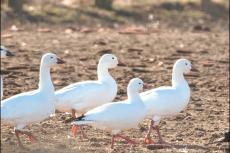Water quality remediation was once again the primary topic on Monday as the East Hampton Town Trustees looked favorably on several proposals aimed at improving impaired water bodies under their jurisdiction.
Molly Graffam of Cornell Cooperative Extension proposed to the trustees a surface water monitoring program in the northwest portion of Accabonac Harbor, slightly more than half of which is permanently closed to shellfishing, with the remainder seasonally closed.
Stormwater runoff is a known source of pathogens and fecal coliform, she told the trustees, but other sources, including groundwater and pollutants such as excess nutrients, may be contributing to water quality declines, along with factors such as increased temperatures and decreased oxygen. There is little publicly available data on the surface water conditions and groundwater pollutants going into the harbor, she said. With no sewer system or sewage treatment plant in the subwatershed, and many private properties in need of septic system upgrades, the harbor may be experiencing excessive nutrients flowing into it by way of submarine groundwater discharge.
Ms. Graffam proposed identifying areas with elevated nutrient and pathogen concentrations in surface water to determine if nitrogen and pathogenic bacteria levels exceed acceptable thresholds. Also to be identified are simultaneously occurring factors such as dissolved oxygen, water level, and temperature, while areas with high rates of groundwater seepage and elevated contaminants in water in the ground’s pore spaces would be located. The information gained would be used for better designs for mitigation strategies, she said, and perhaps other water quality initiatives in the harbor, which could be useful in the reopening of waters closed to shellfishing.
To accomplish this, Ms. Graffam proposed that the extension collect samples from 12 locations, at approximately the same time at low tide. Collected would be data on conductivity, pH, temperature, total dissolved solids, dissolved oxygen, and oxygen reduction potential. Samples would be collected and analyzed for nitrogen and pathogens, specifically fecal coliform bacteria.
Ms. Graffam also sought the trustees’ approval to install five autonomous monitoring stations, for three to six months, that would monitor water level, temperature, and salinity to provide contextual data “that we can use to help understand the other data we’re collecting.”
“We see our work as identifying and targeting shoreline areas in direct need of remediation as well as informing design,” Ms. Graffam said. “Reversing water quality impairments will require management and remediation efforts.” Cornell’s efforts may help justify future projects such as replacing existing septic systems with innovative alternative systems, “and also some of our work is on permeable reactive barriers and nutrient bioextraction.”
Oyster Reef
The trustees also heard from Bob Tymann of South Fork Sea Farmers, which has been described by the director of the town’s shellfish hatchery as the nonprofit educational arm of the hatchery and the town’s community oyster garden program, who provided an update on the plan to create an oyster reef in Accabonac Harbor. It is hoped that the effort will lead to natural propagation while establishing habitat.
As filter-feeding bivalves, oysters help remove excess nitrogen from the water.
Mr. Tymann said that he and the trustees John Aldred and David Cataletto had recently kayaked in the harbor in search of the best site for the reef, identifying one that was away from duck blinds or other obstructions and where the bottomland is solid, which he said is ideal. The reef would rise just 18 inches from the bottom and run parallel to the shoreline for 17.5 yards, at approximately 19.5 yards from the seaward edge of intertidal marsh vegetation. The hope is that it would become a self-sustaining, natural reef, he said.
In order to proceed, the program would require a permit from the New York State Department of Environmental Conservation.
On Georgica Pond
Sara Davison, executive director of the Friends of Georgica Pond Foundation, also spoke to the trustees about the group’s plans for the 2022 season.
Earlier this month, the trustees authorized the foundation once again to use an aquatic weed harvester this summer as part of its ongoing effort to alleviate conditions that have promoted the growth of harmful algal blooms in the pond. Last August, the harvester removed 50,540 pounds of macroalgae, which interfere with surface water currents and shade desirable vegetation. When they die, their decomposition consumes oxygen, stressing or killing marine life and promoting harmful algal blooms such as cyanobacteria, or blue-green algae.
Here, too, an oyster grow-out program should continue and expand, Ms. Davison said on Monday. Sets of cages have been set at three locations in the pond for the last three years and have demonstrated that oysters can survive, grow, and spawn in the pond’s brackish water.
“The next step would be to do some mini-attachments to these cages with spat-on-shell in the presence of predation,” she said, describing oyster larvae that have permanently attached to shell. This would take the project beyond protective cages to determine if oysters could survive in natural conditions.
Along with the aquatic weed harvester, the oyster program is one of several measures aimed at improving water quality in the pond, where blooms of cyanobacteria have fouled it to varying degrees over the last decade. The recent demolition of the restaurant building on Montauk Highway next to the pond, and the re-engineering of both the adjacent rest stop and the concrete drainage pipe that runs from Route 114 to the pond, for which the town will soon issue a request for proposals, will further reduce harmful inputs, Ms. Davison said.
The foundation is also to print a leaflet for pondfront property owners with information about the importance of vegetative buffers between lawns and the pond, with the goal of absorbing and reducing runoff.



